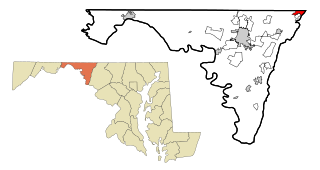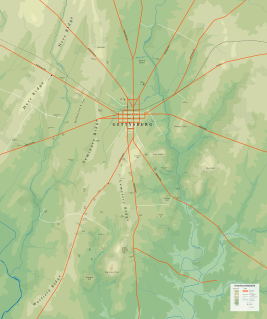
The Gettysburg Battlefield is the area of the July 1–3, 1863, military engagements of the Battle of Gettysburg within and around the borough of Gettysburg, Pennsylvania. Locations of military engagements extend from the 4-acre (1.6 ha) site of the first shot at Knoxlyn Ridge on the west of the borough, to East Cavalry Field on the east. A military engagement prior to the battle was conducted at the Gettysburg Railroad trestle over Rock Creek, which was burned on June 27.

The Northern Central Railway (NCRY) was a Class I Railroad connecting Baltimore, Maryland with Sunbury, Pennsylvania, along the Susquehanna River. Completed in 1858, the line came under the control of the Pennsylvania Railroad (PRR) in 1861, when the PRR acquired a controlling interest in the Northern Central's stock to compete with the rival Baltimore and Ohio Railroad (B&O). For eleven decades the Northern Central operated as a subsidiary of the PRR until much of its Maryland trackage was washed out by Hurricane Agnes in 1972; after which most of its operations ceased as the Penn Central declined to repair sections. It is now a fallen flag railway, having come under the control of the later Penn Central, Conrail, and then broken apart and disestablished. The southern part in Pennsylvania is now the York County Heritage Rail Trail which connects to a similar hike/bike trail in Northern Maryland down to Baltimore, named the Torrey C. Brown Rail Trail. Only the trackage around Baltimore remains in rail service.

The Hanover Subdivision is a railroad line owned and operated by CSX Transportation in the U.S. states of Maryland and Pennsylvania. The line runs from Baltimore, Maryland west to Hagerstown, Maryland along several former Western Maryland Railway (WM) lines. It meets the Baltimore Terminal Subdivision at its east end, and the Lurgan Subdivision heads both north and west from its west end.

The Gettysburg Lincoln Railroad Station, also known as the "Gettysburg Train Station," "Lincoln Train Station" or "Western Maryland Railroad Station," is a historic train station with depot, platform, museum and offices on Carlisle Street in Gettysburg, Pennsylvania. Operable from 1858 to 1942, it contributes to the Gettysburg Battlefield Historic District and is most notable as President Abraham Lincoln's point of arrival on November 18, 1863 and departure, following delivery of the Gettysburg Address. The station served as both a hospital during the battle and hub for outgoing wounded soldiers and incoming resources and supplies following the end of the war. On 2015, following several years of delays, the station, which was originally owned by the Borough of Gettysburg but was bought by the Gettysburg Foundation, the non-profit partner to the National Park Service, was placed under the purview of the National Park Service.

The Hanover Branch Railroad Company was a railroad that operated in Pennsylvania in the mid-19th century. The company was incorporated on March 16, 1847, and began operating trains in 1852. It represents the oldest portion of the Western Maryland Railway. It extended from the connection with the Baltimore & Susquehanna Railroad at Hanover Junction, Pennsylvania, to Hanover.
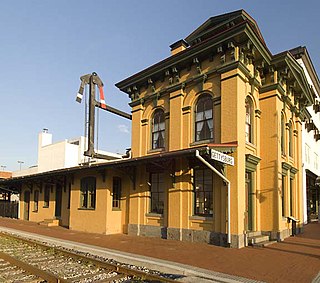
The Gettysburg Railroad was a railway line in Pennsylvania that operated from 1858-1870 over the 17 mile (27 km) main line from the terminus in Gettysburg to the 1849 Hanover Junction. After becoming the Susquehanna, Gettysburg & Potomac Railway line in 1870, the tracks between Gettysburg and Hanover Junction became part of the Hanover Junction, Hanover and Gettysburg Railroad in 1874, the Baltimore and Harrisburg Railway in 1886, and the Western Maryland Railway in 1917.
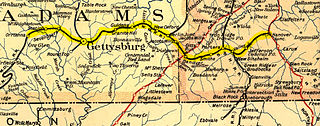
The Hanover Junction, Hanover and Gettysburg Railroad was a railroad line in Pennsylvania in the 19th century. The 38 mile (61 km) main line ran from Orrtanna to Hanover Junction, where it connected with the Northern Central Railway. Connections along the main line were to the Gettysburg and Harrisburg Railroad, the Bachman Valley Railroad, and the Pennsylvania Railroad.
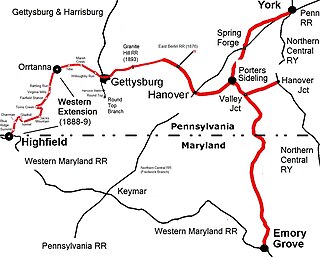
The Baltimore and Harrisburg Railway was a railroad that operated in Maryland and Pennsylvania in the 19th and early 20th centuries. The 59 miles (95 km) main line ran from Emory Grove, Maryland to Orrtanna, Pennsylvania, with a 6 miles (9.7 km) branch from Valley Junction, Pennsylvania to Hanover Junction, Pennsylvania; and later extensions to Highfield, Maryland and York, Pennsylvania.
The Susquehanna, Gettysburg and Potomac Railway (SG&P) was a railroad that operated in Pennsylvania in the 1870s. The 17 mile (27 km) main line ran from Gettysburg to Hanover.
The Baltimore and Hanover Railroad (B&H) was a railroad that operated in Maryland in the 19th century. The 20 mile (32 km) main line ran from Emory Grove, Maryland north to the Pennsylvania state line near Black Rock Junction, where it connected with the Bachman Valley Railroad.

Round Top is a populated place in the U.S. state of Pennsylvania, near Little Round Top. It is notable for two Battle of Gettysburg hospitals, the 1884 Round Top Station, and several battlefield commemorative era attractions such as Round Top Park and the Round Top Museum. The unincorporated community lies on an elevated area of the north-south Taneytown Road with 3 intersections at Blacksmith Shop Road to the northeast, Wheatfield Road, and Sachs Road.

The Gettysburg Electric Railway was a borough trolley that provided summer access to Gettysburg Battlefield visitor attractions such as military engagement areas, monuments, postbellum camps, and recreation areas. Despite the 1896 Supreme Court ruling under the Takings Clause against the railway, battlefield operations continued until 1916. The trolley generating plant was leased by the Electric Light, Heat, and Power Company of Gettysburg to supply streetlights and homes until electricity was imported from Hanover.

The Round Top Branch was an extension of the Gettysburg and Harrisburg Railroad from the Gettysburg borough across the Gettysburg Battlefield to Round Top, Pennsylvania. The branch ran southward from the terminus of the railroad's main line, west of the school and St. Francis Xavier Cemetery, across the field of Pickett's Charge, south of Cemetery Ridge, east of Weikert Hill and Munshower Knoll, and through Round Top to a point between Little Round Top's east base and Taneytown Road. In addition to battlefield tourists, the line carried stone monoliths and statues for monuments during the battlefield's memorial association and commemorative eras and equipment, supplies and participants for Gettysburg Battlefield camps after the American Civil War.

The Gettysburg and Harrisburg Railroad was a railway line of Pennsylvania from Hunter's Run southward to Gettysburg in the 19th century. The north junction was with the South Mountain RR, and a crossing with the Hanover Junction, Hanover and Gettysburg Railroad's westward extension was at Gettysburg. The crossing also served as a junction for westbound trains to transfer southward across the Gettysburg Battlefield via the G. & H. R. R.'s Round Top Branch to the company's Little Round Top Park.

The South Mountain Railroad was a southcentral Pennsylvania railway line for "connecting the Pine Grove works to the Cumberland Valley R. R." and which provided mining and passenger services via a southwest section from Hunter's Run, Pennsylvania, and a northern section from Hunter's Run to the CVRR junction northeast of Carlisle. The northern section merged with the Gettysburg & Harrisburg Railroad line south from Hunter's Run to the Gettysburg Battlefield in 1891 to create the Gettysburg & Harrisburg Railway line, while the branch southwest from Hunter's Run became the Hunter's Run and Slate Belt Railroad line.

The Gettysburg and Harrisburg Railway was a Pennsylvania line from near Carlisle southward to Gettysburg operated by a subsidiary of the Reading Company. The line also included the Round Top Branch over the Gettysburg Battlefield to Round Top, Pennsylvania until c. 1942.

The Tapeworm Railroad was a railway line planned by Congressman Thaddeus Stevens and nicknamed by opponents ridiculing a lengthy serpentine section around the Green Ridge of South Mountain after an orator compared the path to a tapeworm depiction on a product's packaging. Switchbacks were planned on the west slope at Hughs Forge along the E Br Antietam Creek and on the east slope at Stevens' 1822 Maria Furnace along Toms Creek, with 3 east slope tunnels through spurs of Jacks Mountain.

Round Top Station was the southernmost station of the Gettysburg and Harrisburg Railroad and was located west of a blacksmith shop along the Taneytown Road that was in operation in 1880.
Round Top Park was a Gettysburg Battlefield excursion park of 15 acres (6.1 ha) east of Little Round Top near the end of the Round Top Branch and owned by the Gettysburg & Harrisburg Railroad. In addition to amusements, the park provided services during the memorial association era for steamtrain and trolley tourists visiting nearby military sites of the Battle of Gettysburg.
Joseph S. Gitt was a self-taught civil engineer, surveyor and politician from Pennsylvania. After an unsuccessful career as a newspaper publisher, Gitt went back into railroading, estimating that in his career, he had conducted 31 different railroad surveys for a total distance of over 300 miles in his career Gitt either surveyed or engineered most of the railroads constructed in Frederick and Carroll county, Maryland and Adams county, Pennsylvania in the 1855-1885 period with the exception of the civil war.


